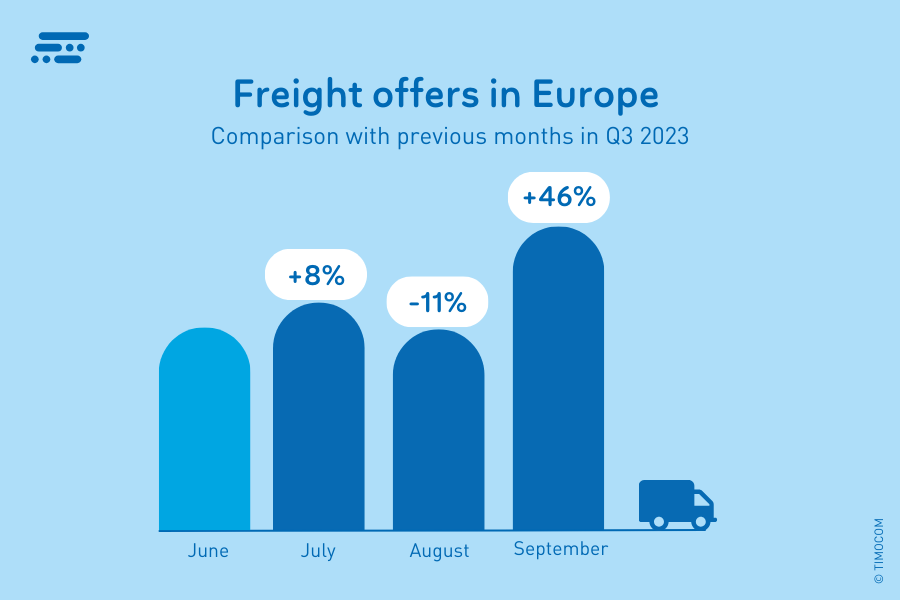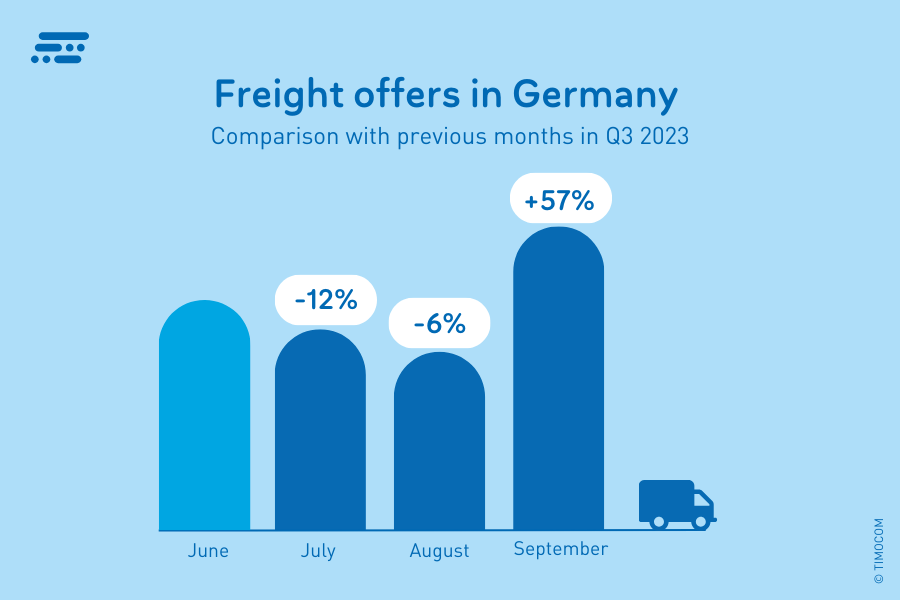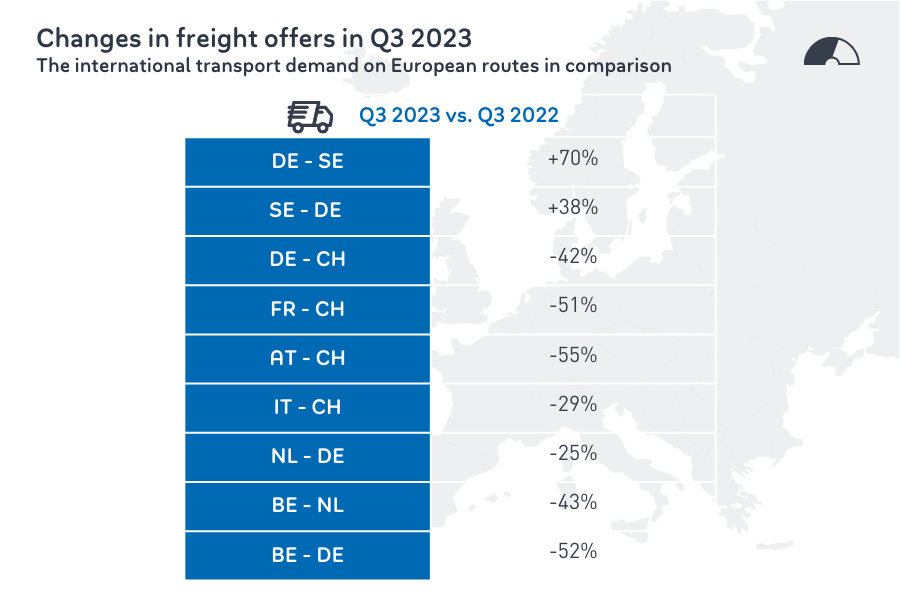Despite a strong September, transport demand remains below the previous year’s level – but is on par with 2019
The TIMOCOM transport barometer for Q3 2023

The ratio of freight to vehicle space has adjusted to 2019 levels, but is still well below the previous year’s figures.
Overall, freight offers in the third quarter of 2023 were 21% below the previous year’s figure. The freight to vehicle space ratio is levelling out to pre-COVID levels from 2019. The increased demand for transport in September led to an increase in the average freight price.
The transport barometer showed exceptionally low and high values in the COVID years. This year, it has levelled off again at the 2019 level. Despite a slight recovery compared to the previous quarters, the transport market continues to weaken.
After freight offers across Europe were significantly below the previous year’s figures in the first two quarters of this year (Q1 −51%; Q2 −46.3%), the gap narrowed in the third quarter, but still totalled 21%. September was the strongest month for freight offers in this quarter, but it was still 13% below the previous year’s figure in September 2022. The number of offers within Germany was even 32% lower in Q3 than in the same quarter of the previous year.
As expected, demand for transport capacity increased again after the summer break. In September, the TIMOCOM Marketplace once again saw a significant increase in demand for transport. Across Europe, 46% more freight offers were generated than in August. In Germany, there were 57% more offers. The freight to vehicle space ratio in Europe was 64 to 36 in July, 57 to 43 in August and was therefore less balanced in September at 69 to 31.
The change in freight offers in Europe in Q3 2023. 
Economic development drives down demand on the transport market
Despite falling inflation, the weakening economy continues to have a negative impact on the transport industry. One reason for this is the significant downturn in the construction sector, which is having a negative impact on the order situation for transport companies. However, cautious consumption and a lack of investment in many areas are also possible reasons why the previous year’s figures have not been matched – both in the private sector, as the GfK consumer climate index shows, and in the commercial sector. This is confirmed by the ifo Business Climate Index, which has fallen from 87.4 to 85.7 over the past three months, even though respondents’ expectations improved slightly in September.
This development is having a negative impact on the retail sector. According to the Federal Statistical Office of Germany, sales fell by 1.2% in real terms in August 2023 compared to the previous month. Compared to the previous year, the decrease was as much as 2.3%. According to the consumer price index, food prices rose by an above-average 9.0% and, together with energy prices, kept the inflation rate high.
“Due to developments in the economy, overall demand for vehicle space in Europe was low compared to 2022, even though freight supply figures showed a slight increase last month”, says Gunnar Gburek, Head of Business Affairs at TIMOCOM. “The transport market in Germany is acting cautiously and reflects the overall economic development. The main reasons for this are weak foreign demand and the domestic economy.” Gburek adds that it is unlikely that we will see a significant increase in demand for transport this year. “If the transport market continues to develop at the same level as in 2019, demand for vehicle space will fall again in the fourth quarter of 2023. This seems realistic in view of the economic situation in Europe and especially in Germany.”
The change in freight offers in Germany in Q3 2023. 
Average freight price reaches its highest level so far this year
Following the increase in freight offers, the average freight price per kilometre rose by 6.5% in September compared to the previous month. This figure is as much as 21.3% higher than this year’s low in February. Despite this increase over the course of the year, however, all prices are still well below the highs of 2022, when demand was much higher.
More freight offers to and from Sweden
There were notable shifts in freight offers on the route between Germany and Sweden, among others. Offers from Germany to Sweden in particular rose by 70% compared to the same quarter of the previous year. From Sweden to Germany, freight offers were up by 38%. Sweden’s exports include vehicles, wood products and pharmaceutical goods, as well as iron and steel. Germany is Sweden’s number 1 trading partner for goods imports. According to the German-Swedish Chamber of Commerce, Germany is second only to Norway in terms of exports. Both imports and exports also exceeded the pre-COVID trade figures. The main imports from Germany are machinery and pharmaceuticals.
Lower demand for transport to Switzerland
Demand for transport capacity declined on numerous routes to Switzerland in Q3, despite the disruption to rail transport caused by the Gotthard tunnel, which was expected to lead to an increase in road freight transport. For example, there were 55% fewer freight offers on the route from Austria to Switzerland and 51% fewer freight offers from France to Switzerland than in the previous quarter. There were 42% fewer offers from Germany to Switzerland than in the previous year and 29% fewer freight offers from Italy. As the rail link is expected to remain closed for several months, an increase in road freight transport around Switzerland can be expected in the fourth quarter.
Freight services from Belgium and the Netherlands to Germany also declined (BE-DE −52%; NL-DE −25%). One reason for this is the decline in inland transport from the seaports. Container throughput in the ZARA ports has continued to decline since the beginning of the year.

A comparison of changes in freight offers on European routes.
About the TIMOCOM transport barometer
The FreightTech company TIMOCOM has been using the transport barometer since 2009 to analyse the development of transport offers and demand as recorded by the freight exchange integrated into the Marketplace. More than 154,000 users generate up to one million international freight and vehicle space offers daily.